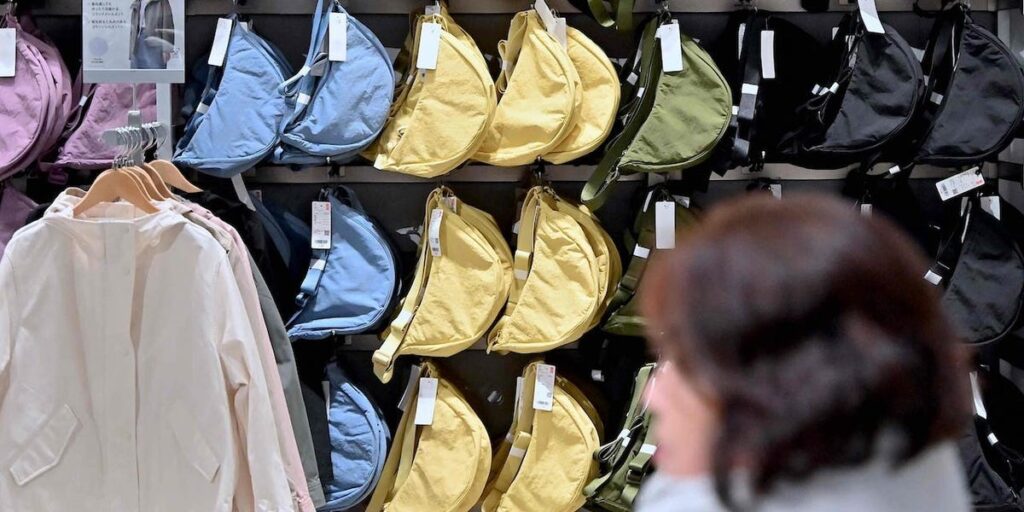- Uniqlo’s parent recently reported record earnings for the third year running, bolstered by strong sales at Uniqlo.
- The brand focuses on functional basics rather than chasing trends.
- Its success is bolstered by Japanese brand trust.
Uniqlo is on to something.
Its Japanese owner, Fast Retailing, posted record earnings for the third year running this month, with revenues at Uniqlo soaring 19% in international markets and 4.7% in Japan for the 12 months to August.
The chain is thriving in the middle-market retail ecosystem alongside fast-fashion heavyweights like Zara, whose parent company reported a 10.2% increase in sales in constant currency during the first half of 2024. Sales at Zara alone were up 5.4%.
H&M Group, meanwhile, has lagged behind its competitors — its net sales were flat during the first nine months of the year.
Uniqlo has built a successful business model by producing functional, basic clothing and eschewing the practice of fast-retail rivals who regularly drop new styles inspired by the latest catwalk shows.
Fitting the times
Uniqlo opened its first store in Hiroshima in 1984.
Known for its affordable basics and wardrobe staples, being a fashionable clothing store was never high on Uniqlo’s agenda. Yet in recent times, it has found itself setting trends — its $20 cross-body shoulder bag, which has become a fashion staple and dubbed the “millennial Birkin,” being one recent example.
In 2006, it also opened GU, a sister brand more focused on selling trendy clothes and targeting younger shoppers.
But people have always needed basics, so Uniqlo’s business model is in a sweet spot now more than ever as it aligns with evolving consumer tastes.
“It is good quality for the cost,” 27-year-old Gen Z luxury fashion content creator Kate Yuille says about why her generation gravitates to Uniqlo. “People have started to notice that and are maybe suggesting it as an alternative to things like Pretty Little Thing or even H&M.”
Amrita Banta, managing director of luxury insights firm Agility Research & Strategy, says Uniqlo’s “classic and understated” collections appeal to consumers with different price points.
Amid the downturn in luxury retail, wealthy and aspirational consumers are warming to the idea of pairing designer pieces with items from midlevel brands — a trend that Gen Z has already been on for the last few years.
“I think the mix-and-match element of fashion that’s happened works for them,” Banta says. “You can wear a Moncler when you need to, but you can also wear a Uniqlo smart beige jacket and look pretty decent in it.”
Leaning into sustainability
Another marked difference between Uniqlo and fast fashion players is that people take its penchant for sticking to basics and functional clothing instead of producing a plethora of styles as aligning with the “slow fashion” movement.
“From the environmental point of view, I think consumers feel like you’re sinning a little less by shopping Uniqlo because it just seems to be so much more understated,” says Martin Roll, a global business strategist and senior advisor at McKinsey.
It hasn’t escaped greenwashing accusations in the past or allegations of human rights violations along its supply chains. And even though it is producing staple wardrobe pieces, it’s producing a lot quickly.
However, Uniqlo does have ambitions to become more sustainable. These include increasing the proportion of its clothing made from recycled materials, launching clothing repair studios, and aiming to reduce its greenhouse gas emission levels by 90% by 2030.
Uniqlo thinks of itself as a tech company
Tadashi Yanai, CEO of Uniqlo and founder of Fast Retailing, once said, “Uniqlo is not a fashion company — it’s a technology company.”
In practice, that means valuing product development and innovation through strategies such as collaborating with Toray, a material manufacturer headquartered in Japan that describes itself as devoted “to the development of new fields and materials” and producing “cutting-edge, high-value-added products.”
Yanai told The Telegraph in 2016 that he was not interested in chasing the ever-evolving cycle of fashion trends: “We want to sell good clothing to all people, not just the few.”
That’s why Uniqlo releases new collections seasonally, whereas rivals such as Zara produce about 500 new designs weekly.
Roll says Zara has to be “sharp every day. “Uniqlo doesn’t have the same pressure.”
Its stores are also neatly laid out and uncluttered.
“All the touchpoints are very well taken care of. You will never see a box of clothing getting in your way in one of the aisles,” Roll adds.
Innovation, the backbone of the tech industry, is also entwined with how Uniqlo markets collections like HeatTech, its thermal line, and Pufftech, its puffer jacket range.
“You feel like you’re getting more for what you’re paying,” Yuille says, referring to the infusion of tech verbiage in Uniqlo’s branding.
The power of Japanese brand trust
Japan’s weak currency may be working to Uniqlo’s advantage in Japan and its international markets — it makes shopping for tourists more appealing in its home market and boosts the value of its sales abroad. However, that’s not the only reason its heritage is key to its winning streak.
For one, there’s a sense of trust among consumers for Japanese-founded brands as they have historically represented a feeling of quality and dependability, Roll says.
And over the last 40 years, the company has leaned into this, writing its own rules rather than trying to compete with Zara and H&M, Roll says.
He thinks Uniqlo comes with “a bit of this myth of the Japanese psyche. Japanese design is uncluttered simplicity, down to earth, nature, balanced in the values. It doesn’t try to pretend something which is bigger than they can actually deliver.”
Read the full article here


